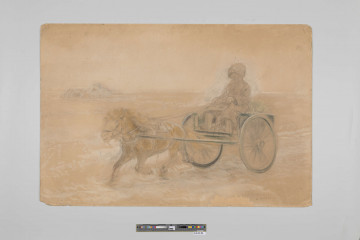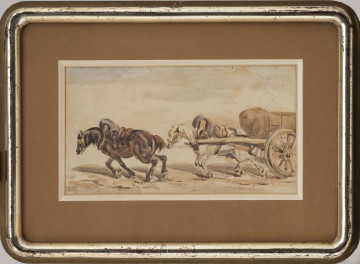
Remains of the castle in Sielec
1857
National Museum in Lublin
Part of the collection: Polish landscape painting (19th–1st half of the 20th c.)
The painting probably depicts a scene of a return from a hunt, shown in a rather unusual way. A cart with a lone coachman is slowly rolling towards the village on a sandy road between fields and forest. Hunting dogs are running behind the wagon. A few of them lag and bark at a scarecrow standing at the edge of the road. In a composition depicting a small part of the landscape, this group is in the foreground. The author of the painting, Zygmunt Ajdukiewicz, who settled permanently in Vienna, left in his oeuvre many works being a similar type of representation, i.e., episodes with people and animals against the background of an idyllic landscape.
Thanks to the patronage of his cousin Kazimierz, a renowned portraitist of the imperial court and the upper classes (the author of the excellent portrait of Helena Modrzejewska), Zygmunt gained a significant artistic position also in established circles. For this reason, he created images of dignitaries and aristocrats, but he also undertook historical and genre themes, ‘recalling certain historical-step customs from the borderlands of old Poland’. This particular trend of painting – customs, hunting and market scenes, in which skilfully painted horses and dogs were an obligatory element enjoyed the most outstanding recognition due to its anecdotal and decorative values European art consumers of the time.
The central part of the painting in question – a realistic and expressive representation of three dogs, reflecting the nature of these animals – evokes associations with old animalistic painting. The most outstanding examples of this genre come from the 17th-century Dutch and Flanders workshops. The works of such masters as Abraham Hondius or Frans Snyders also found followers in Polish art of the 19th century. In combination with landscape, genre and battle motifs, animals appeared on the canvases of Piotr Michałowski, Juliusz Kossak, Józef Chełmoński, Alfred Wierusz-Kowalski and many other artists of the time.
Zygmunt Ajdukiewicz became famous among his compatriots for his skill in painting horses. However, he gained the greatest fame with twelve paintings dedicated to Tadeusz Kościuszko's life and illustrations to Sienkiewicz's Potop (Deluge). The Kościuszko cycle was published in an album by Franciszek Bondy's Publishing House from Vienna, which also published Artur Grottger's drawing cycles.
Bożena Kasperowicz
Author / creator
Dimensions
cały obiekt: height: 77,5 cm, width: 56 cm
Object type
painting
Technique
oil technique
Material
canvas, oil-based paint
Creation time / dating
Creation / finding place
Owner
The National Museum in Lublin
Identification number
Location / status

1857
National Museum in Lublin

1915
National Museum in Lublin

1844 — 1846
National Museum in Lublin
DISCOVER this TOPIC
Castle Museum in Łańcut
DISCOVER this PATH
Educational path